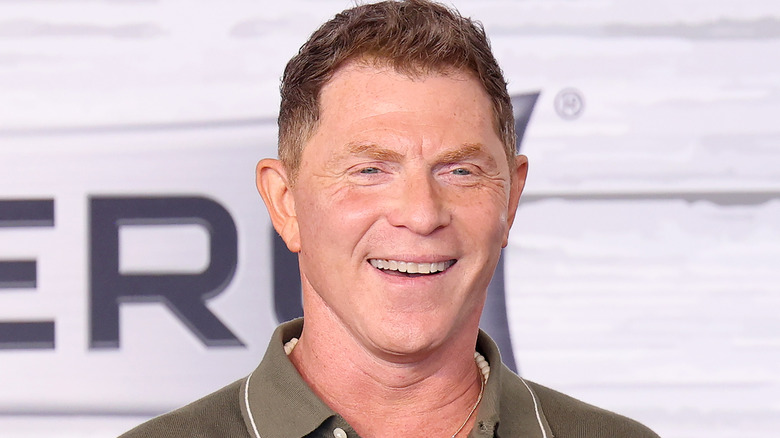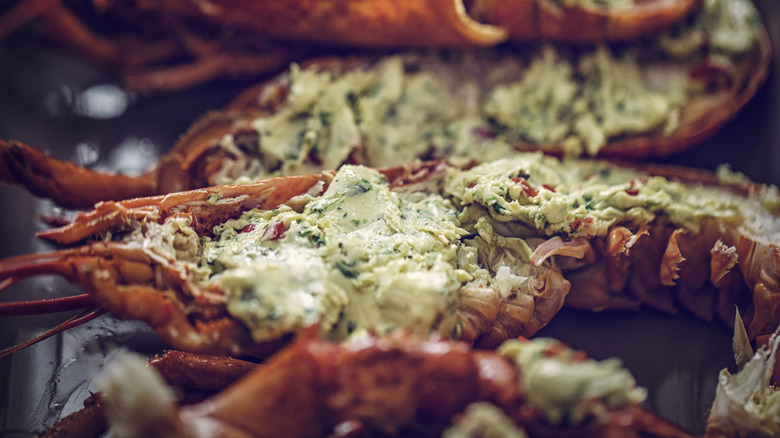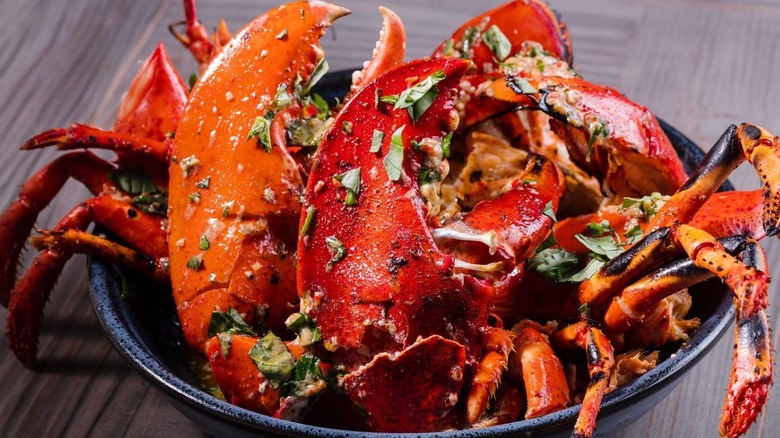The Step Bobby Flay Never Skips When Grilling Lobster
We may receive a commission on purchases made from links.
If you're in search of culinary inspiration for your next outdoor soiree, look no further than Bobby Flay's whole grilled lobster drizzled with compound butter. However, the chef doesn't just toss raw lobster on the grill: He blanches (or steams) it first.
Flay's multi-step cooking method may seem a little unorthodox, but we expect nothing less from the chef known for big flavors. To coax the maximum amount of deliciousness from the crustacean, he blanches or steams the lobster before placing it on the grill. Parcooking prevents the meat from overcooking and becoming tough once you place it on the grill. Compared to boiling, blanching is a gentler way to cook without diluting its flavor. Conversely, placing live lobsters on a hot grill can result in charring the outside, leaving the center raw.
Since the lobsters will still cook on the grill to develop a smoky flavor, Flay cooks them until they are roughly three-quarters done. This enables the meat to relax before finishing it on the grill, so it remains tender. For reference, when you do this at home, a 1½ pound lobster takes roughly 14 minutes to cook fully, so it should be removed from the steamer after 10 minutes.
Tips for grilling lobster
Unlike most protein you purchase at the supermarket, lobsters are alive, which can be challenging for certain people to cook. If you are squeamish about steaming the squirming crustacean, follow Ina Garten's advice on how to humanely cook live lobster. In her cookbook, "Cook Like A Pro," Garten suggests using the tip of a knife to pierce the area between the head and tail, so it doesn't suffer. If that's too much, ask your fishmonger to do it.
When removing the parcooked whole lobster from the pot, it will be bright red even though it's not finished cooking. Once it's cool enough to handle, you want to split the lobster lengthwise in half. This serves several purposes: It enables the meat to cook quicker, limiting the risk of overcooking, but more importantly, it gives you an opportunity to flavor the succulent lobster meat. Bobby Flay coats his lobsters with oil, salt, and pepper, but clarified butter is also delicious. Melted butter will burn quickly on a hot grill, but when you remove the milk solids, aka ghee, butter's smoking point increases to 400 degrees Fahrenheit.
Not only does Flay's method deliver a delicious meal, but when entertaining, it enables you to prepare the lobsters up to the grilling in advance. Just before serving, season each half and gently grill them for a few minutes, shell-side down. Then, flip the lobster briefly to impart a smoky flavor to the meat.
Tips for serving grilled lobster
Although half a grilled lobster served on a plate makes an attractive presentation, Bobby Flay carves the spiny crustacean a little further to make it easier to eat. This is also a great way to stretch the lobster meat further, serving it family style. Flay uses a chef's knife to remove the tail, then separates the claws from the body. If you're counting, the lobster is now in six pieces, with the claws cracked to access the sweet meat. He serves the dish in a shallow bowl, which makes sense once you see how much melted butter he drizzles on the finished dish.
Known for using hot peppers, one of the ways Flay cooks his lobster is by creating a red chile-garlic butter with chipotle in adobo and fresh herbs, providing plenty of heat and brightness to the smoky lobster. If the heat is too much, try our recipe for whole grilled lobster, basting the meat with a mixture of sauteed garlic, kosher salt, freshly ground black pepper, lemon juice, and melted butter. A sprinkling of fresh parsley or tarragon is delicious. Serve the lobster with the perfect drink and plenty of napkins. Dry white wine always goes well with seafood, but if you are in the mood for something else, try a citrusy IPA or salty margarita to complement the buttery lobster.



